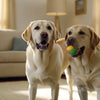Understanding Why Do Dogs Take Kibble Out of Bowl: Insights for Pet Owners
- Houndsy
Table of Contents
- Introduction
- The Instinctual Roots of Kibble Carrying
- Factors Influencing Food-Carrying Behavior
- The Role of Training in Managing Food Behavior
- Conclusion
Introduction
Imagine settling down with your favorite snack, only to find that a furry friend is mysteriously carrying pieces of their food away, leaving a trail of kibble in their wake. If you're a dog owner, you might have experienced this quirky behavior firsthand, leading you to wonder: why do dogs take kibble out of the bowl? This behavior is more common than you might think, and understanding the reasons behind it can help improve your dog feeding routine and your pet's overall well-being.
In this blog post, we’ll delve deep into the psychology and instinctual behaviors that drive dogs to take their food away from their bowls. We will explore the various reasons behind this behavior, from instinctual tendencies to environmental factors, and how it reflects their relationship with their food and surroundings. By the end of this article, you will gain valuable insights into why your dog might prefer to nibble on kibble in a different location, along with practical tips on how to address any related issues.
As we unpack this topic, we encourage you to reflect on your own pet's feeding habits. Do they prefer to eat in a quiet corner? Do they carry their food elsewhere? Understanding these behaviors can help us enhance our pets' feeding experiences, making mealtime an enjoyable ritual.
Let’s explore the fascinating world of dog behavior and the many reasons why our beloved pets indulge in this peculiar habit.
The Instinctual Roots of Kibble Carrying
Evolutionary Background
Dogs are descendants of wolves, and many of their behaviors still reflect their wild ancestry. In the natural world, animals often have to safeguard their food from competition. This instinct is rooted in the survival mechanisms of early canines, who would carry food away from the kill to avoid confrontation with other pack members. This behavior is known as resource guarding.
Resource Guarding
When your dog takes kibble out of their bowl and moves it to another location, they may be expressing an instinct to protect their food. This behavior can be particularly pronounced in multi-dog households, where competition for resources is more visible. Your dog may feel the need to move their food to a "safer" place, away from perceived threats.
Modern Implications
While many of us have domesticated pets that don’t face the same threats their ancestors did, these innate behaviors still manifest in our dogs. They may carry their food to a quieter area or a spot they perceive as more secure. Understanding this instinct can help us create a more harmonious feeding environment for our furry friends.
Factors Influencing Food-Carrying Behavior
1. Loneliness and Companionship
Dogs are social animals that thrive on companionship. If your dog feels isolated while eating—perhaps because they are alone in the kitchen— they might instinctively carry their food to where you are. This behavior shows their desire to be part of the family dynamic during mealtimes.
Tip: If you find that your dog prefers to eat near you, try to create a comfortable eating space for them in the same room where you spend time. This could enhance their mealtime experience and strengthen your bond.
2. Bowl Preference
Believe it or not, your dog's choice of bowl can significantly affect their eating habits. Dogs can be picky about the materials or sounds associated with their food bowls. For instance, a metal bowl may clang and startle them, prompting them to take their kibble elsewhere.
Tip: Experiment with different types of bowls—ceramic, silicone, or even elevated options. An ergonomic design can enhance their comfort while eating, encouraging them to stay at the bowl.
3. Environmental Stressors
If your dog’s feeding area is in a busy or noisy part of your home, they might feel anxious or stressed during mealtime. This may lead them to take their food to a quieter, more comfortable spot.
Tip: Observe your dog's behavior during mealtime. If they seem anxious, consider relocating their food bowl to a quieter area where they can eat without distractions.
4. Discomfort While Eating
For some dogs, the act of bending down to eat from a bowl can be uncomfortable, especially for older dogs or those with joint issues. If your dog is moving kibble away from a bowl on a hard surface, they may be seeking a softer, more comfortable area to eat.
Tip: Consider elevating your dog’s food bowl to a height that’s comfortable for them, or provide a soft mat under the bowl to reduce discomfort.
5. Caching Behavior
Another reason dogs might carry food away is to create a personal stash. In the wild, canines would often hide leftover food to save it for later. This instinct can manifest in domestic settings, where your dog might drag kibble to different parts of the house.
Tip: Monitor your dog's portion sizes to ensure they’re not being overfed, which can contribute to caching behavior.
The Role of Training in Managing Food Behavior
Addressing Food-Carrying Behavior
While many dogs exhibit food-carrying behavior without any negative implications, it can sometimes become problematic—especially if it leads to a mess in your home. If you want to curb this behavior, there are several strategies you can adopt.
-
Structured Feeding Times: Establish a routine that helps your dog understand when it’s time to eat. Consistency can help reduce anxiety around mealtime.
-
Feeding Separately: If you have multiple pets, consider feeding them in separate areas to minimize competition and stress.
-
Behavioral Training: Reinforce positive behaviors during feeding. For instance, if your dog stays by their bowl, reward them with praise or treats.
-
Using Interactive Feeders: Consider using puzzle feeders or slow-feed bowls that engage your dog mentally and slow down their eating pace. This can help them focus on the task at hand instead of moving around.
-
Consulting a Professional: If the behavior persists and is concerning, don't hesitate to consult a veterinarian or a professional dog trainer for personalized advice.
Conclusion
Understanding why dogs take kibble out of their bowls can open up a new world of insights into their behavior and needs. From instinctual resource guarding to a desire for companionship, each reason reflects the unique personality and history of our canine companions. As responsible pet owners, it is our duty to create a feeding environment that accommodates their instincts while also aligning with our lifestyles.
By implementing the strategies we discussed, we can enhance our pets' mealtime experiences, making them not only more enjoyable but also healthier. If you're looking to elevate your feeding experience even further, consider exploring the Houndsy Kibble Dispenser. With its mid-century modern design and ergonomic convenience, it can simplify and beautify your dog feeding routine, ensuring consistency and reliability every time.
Frequently Asked Questions (FAQ)
Why do dogs take food from the bowl and eat elsewhere?
Dogs may take food from their bowl and eat elsewhere to protect it from perceived threats or to be closer to their owner.
Why does my dog drop his food on the floor before he eats it?
Dogs might drop their food on the floor before eating it due to discomfort with their bowl or to examine it more closely.
Why do dogs take their food to another room?
Dogs take their food to another room to eat in a quieter or more comfortable location or to be near their human companions.
By understanding and accommodating these behaviors, we can ensure our furry friends lead happy, healthy lives. Let's make mealtime a joyful experience for both of us!












